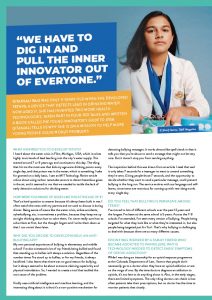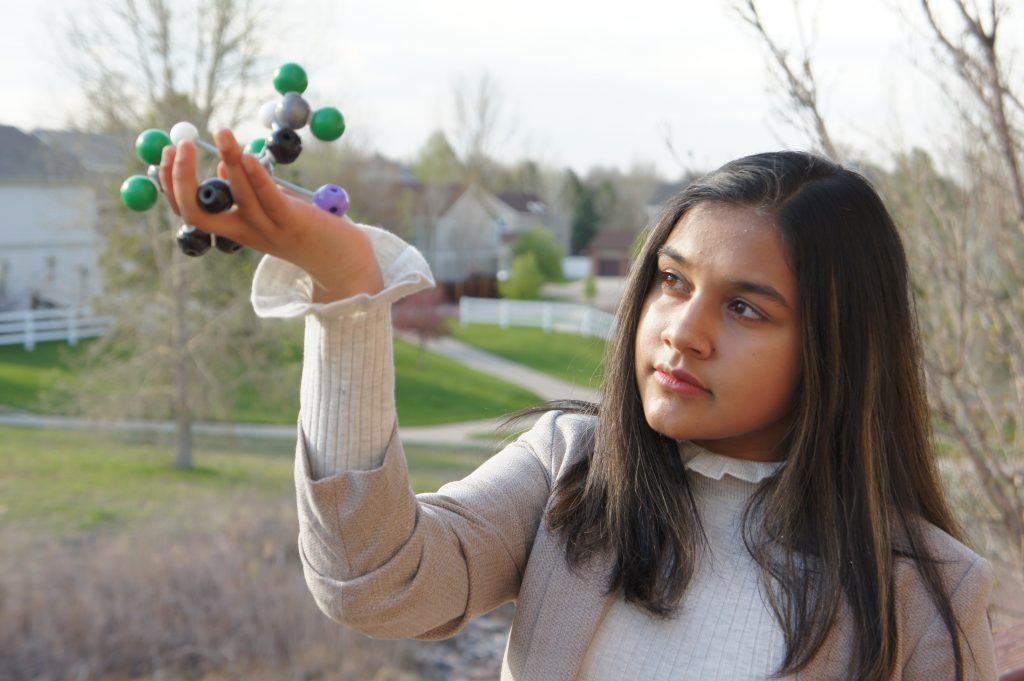“We have to dig in and pull the inner innovator out of everyone.”
Gitanjali Rao was only 11 years old when she developed Tethys, a device that detects lead in drinking water. Now aged 17, she has invented two more health technologies, taken part in four TED talks and written a book called The Young Innovator’s Guide to STEM. Gitanjali tells us why she is on a mission to help more young people solve world problems
WHAT INSPIRED YOU TO DEVELOP TETHYS?
I heard about the water crisis in Flint, Michigan, USA, which involves highly toxic levels of lead leaching into the city’s water supply. This started around 7 or 8 years ago and continues to this day. The thing that hit me the most was that kids my age were drinking poison every single day, and that poison was in the water, which is something I take for granted on a daily basis. I saw an MIT Technology Review article online about using carbon nanotube sensors to detect hazardous gases in the air, and it seemed to me that we needed to tackle the lack of early detection solutions for drinking water.
HOW WERE YOU AWARE OF ISSUES LIKE THIS AT THE AGE OF 11?
That’s a hard question to answer because it’s always been built in me. I often watch the news with my parents and we used to discuss it during dinner. Being aware of issues like the water crisis, airline accidents, cyberbullying, etc. is sometimes a problem, because they keep me up at night thinking about how to solve them. I’m never really sure how to solve them at first, but the thought lingers and I write them down so that I can revisit them later.
WHY DID YOU DECIDE TO DEVELOP KINDLY, AN ANTIBULLYING APP?
My own personal experience of bullying in elementary and middle school! I’ve also witnessed a lot of my friends being bullied and found that standing up to bullies isn’t always a solution. Regardless of the number times I’ve stood up to bullies, or for my friends, it always backfired. I also learned that there was no good reason for bullying, but it always seemed to be about someone claiming superiority and physical intimidation. So, I wanted to create a tool that tackled the root cause of the problem.
Kindly uses artificial intelligence and machine learning, and the interesting thing about it is that it’s a non-punitive mechanism for detecting bullying messages. It works almost like spell check in that it tells you that you’re about to send a message that might not be very nice. But it doesn’t stop you from sending anything.
The inspiration behind this was drawn from an article I read that said it only takes 7 seconds for a teenager to want to unsend something they’ve sent. Giving people those 7 seconds, and the opportunity to decide whether they want to send a particular message, could prevent bullying in the long run. The service evolves with our language and self-learns, since teens are notorious for coming up with new slang words every single day.
DO YOU FEEL THAT BULLYING IS PERVASIVE AMONG TEENS?
I’ve moved to lots of different schools over the past 12 years and the longest I’ve been at the same school is 5 years. Across the 7-8 schools I’ve attended, I’ve seen every version of bullying. People being targeted for what they look like or what they’re interested in, but also people being targeted just for ‘fun’. That’s why bullying is challenging to deal with because there are so many different causes.
EPIONE WAS INSPIRED BY A FAMILY FRIEND WHO BECAME ADDICTED TO PAINKILLERS. WHY IS TECHNOLOGY NEEDED TO DETECT EARLY SYMPTOMS OF OPIOID ADDICTION?
While I was doing an internship for an opioid response programme at the Colorado Department of Law, I learned that people don’t necessarily go to a doctor when they have an opioid addiction or are on the verge of one. By the time doctors diagnose an addiction to opioids, it’s too late to do anything about it. Also, in the early stages, there are limited symptoms. The only thing doctors can check is how often patients take their prescriptions, but no doctor has the time to monitor patients that closely. There are lots of preventative measures and treatment solutions in place, such as behaviour questionnaires, but no diagnostic solutions. Patients are handed a survey in the doctor’s office, but anyone who has an addiction will lie because their brain wants them to keep using the opioids.
ARE ALL THREE OF THESE TECHNOLOGIES IN USE OR IN THE DEVELOPMENT STAGE?
Tethys is a patented product and I’ve been trying to partner with a manufacturing company for about three years now to start field testing in schools. In partnership with UNICEF, Kindly has been launched worldwide for everyone to start using. Epione is at the prototype stage.
DO YOU HAVE ANY OTHER TECHNOLOGIES OR IDEAS IN DEVELOPMENT?
Yes, a couple of things! One of the bigger things I’m working on is a test strip to detect parasites in drinking water in third-world countries, specifically cryptosporidium. I’m excited about using biotransducers for detection – taking in a biological input like DNA and protein and receiving an electrical output, like resistance in an electrical current.
WHY CRYPTOSPORIDIUM, IN PARTICULAR?
We’ve looked at other parasites as well, and worked with E. coli and legionella, but I wanted to look at something that wasn’t widely known but causes so many problems in third-world countries, like those in Africa and Southeast Asia. The nice thing about this technology is that it’s repeatable; it can be used for different parasites.
YOU WERE RECENTLY A RESEARCH INTERN AT THE KOCH INSTITUTE FOR INTEGRATIVE AND CANCER RESEARCH. HOW DID YOU GET INVOLVED WITH THAT?
I reached out to Dr Sangeeta Bhatia at the Koch Institute and said I was coming to Boston for the summer. I’ve known Dr Bhatia for a very long time and have always looked up to her and followed her work. She is an innovator, an accomplished professor, an entrepreneur and runs multiple labs. She was kind enough to invite me to her lab at the Institute for a month. I met her PhD graduate researchers and worked with them on a project investigating how to improve drug delivery for lung tumours. Dr Tahoura Samad was my mentor. She was such an inspiration, and guided me and allowed me to shadow her research.
HOW DID YOU BENEFIT FROM THIS EXPERIENCE?
Being in a lab for a good length of time meant that I felt like a graduate student. I’d never had the opportunity to have work experience over a longer period. It also gave me an insight into the discipline, diligence, perseverance and motivation you need for research, and the basic methods.
YOU HAVE DONE FOUR TED TALKS SO FAR. HOW DO YOU PREPARE FOR THESE?
In the beginning, I was very nervous but now these talks are second nature to me. I think the biggest thing I’ve learned is that I know my content more than anyone else. If I mess up, I learn from it and I make it work next time. I used to write out a speech and memorise it, word for word, but now I write down the points that matter and go from there. As long as I have made it valuable for the audience with some key messages I want to share, I believe I have accomplished my goals.
WHY DID YOU WRITE THE YOUNG INNOVATOR’S GUIDE TO STEM?
It was at the beginning of the COVID-19 pandemic, and I realised that one girl can’t solve all the world’s problems and we need more young innovators, so I started conducting online workshops and guiding students through a five-step process where they can start their own innovation journey. But I wanted to reach out to more educators and students globally. I wanted to write a prescriptive guide on how to innovate and come up with solutions. To sustain the workshops beyond schedule and time constraints, I saw the book as a way to reach many more students across the world.
This book is targeted at students, but also has lesson plans for teachers as well as sections for parents. It’s a short read and has a list of competitions that students can participate in. The book also talks about my failures and intends to show students that failure is the first step to learning and need not be stigmatised.
YOU HAVE SO MANY WORK INTERESTS AND HOBBIES. WHICH DO YOU FIND THE MOST REWARDING?
The workshops. Whenever I finish a workshop, whether I’m working with 100 or 5,000 students, or sometimes even five, I feel like there are 100 or 500 or 5,000 new ideas brewing. I’ve never seen a student, among the 70,000 I’ve worked with, who hasn’t been interested in innovating something. I think you have to dig in and pull the inner innovator out of everyone. When I do that in my workshops, I feel hugely motivated because there are more young people like me who are looking to solve world problems.
I learn from them as well. I understand their cultures and constraints better now so that I can provide the right resources, if needed. For example, I recently helped find funding to build a space with better internet access for Kakuma refugee camp students. That was a basic need we had to tackle before inspiring the students to innovate.
WHAT ARE YOU HOPING TO STUDY AT UNIVERSITY?
I would like to focus my area of study at the intersection of biogenetics and product development. My research, and work, so far includes biological and biomedical solutions that address health problems in communities.
I would love to minor in public administration to make innovation and problem-solving part of K-12 education, by exploring and influencing educational policies. I’m applying to colleges right now and I hope to get admitted in a university where I can continue with my research and global outreach.
WHAT DO YOU IMAGINE YOURSELF DOING IN 10 YEARS’ TIME?
My eventual goal is to develop solutions into high-quality and cheaper consumer-products. In addition to core research areas, I plan to pursue supplemental public administration, business courses in product development and/or entrepreneurship.
WHAT VALUABLE LESSONS HAVE YOU LEARNED SO FAR?
The biggest thing I’ve learned is that risk-taking is worth it. I wouldn’t be here if it weren’t for the risks I took along the way and for my mentors. Another big thing I’ve learned is that innovation and creativity don’t have deadlines – everything is an ongoing cycle that starts and stops, and starts up again. Last, but not least, failure is such an integral part of the process. My teacher once told me there’s no such thing as failure, there’s just another way of doing it. This message often works for me.
CAN YOU GIVE AN EXAMPLE OF WHEN YOU HAVE MESSED UP?
Oh, lots of examples! You can’t go into a lab and not expect to mess up the first few times until you get something right. A lot of my work is about fine-tuning and testing. That’s one of my favourite things about science. It gives you the opportunity to reboot and restart.



